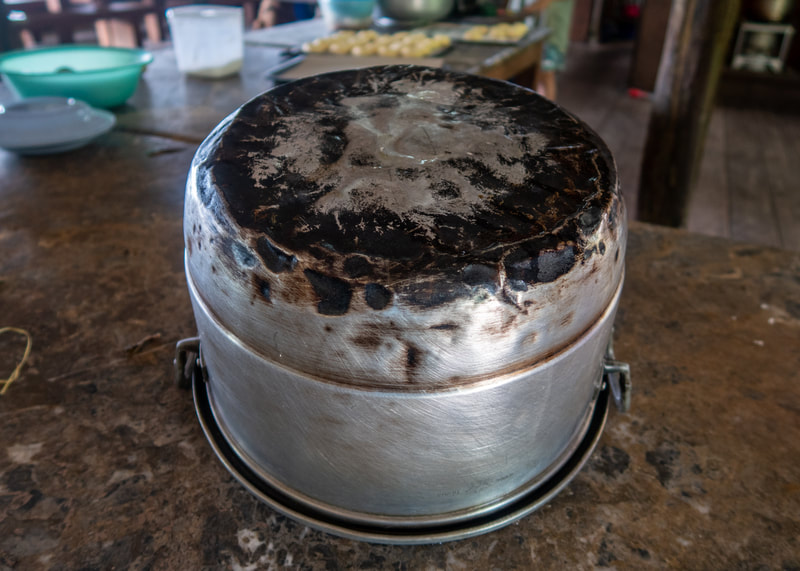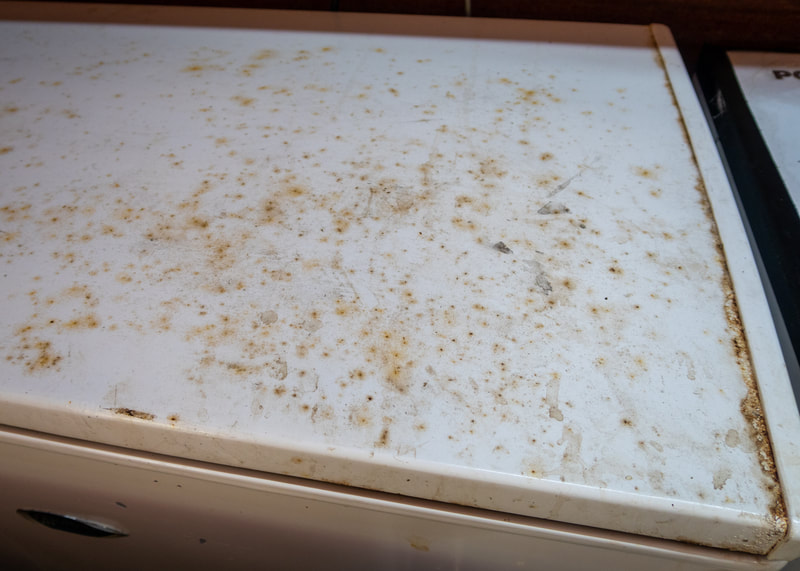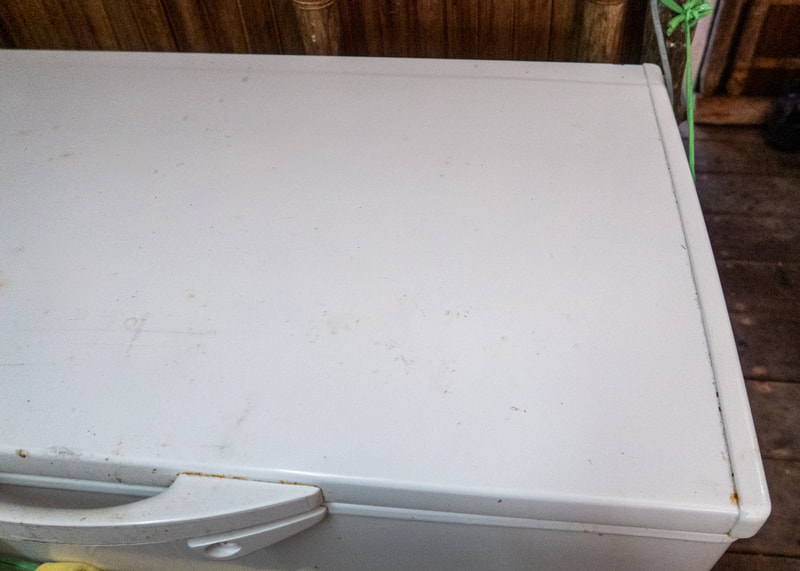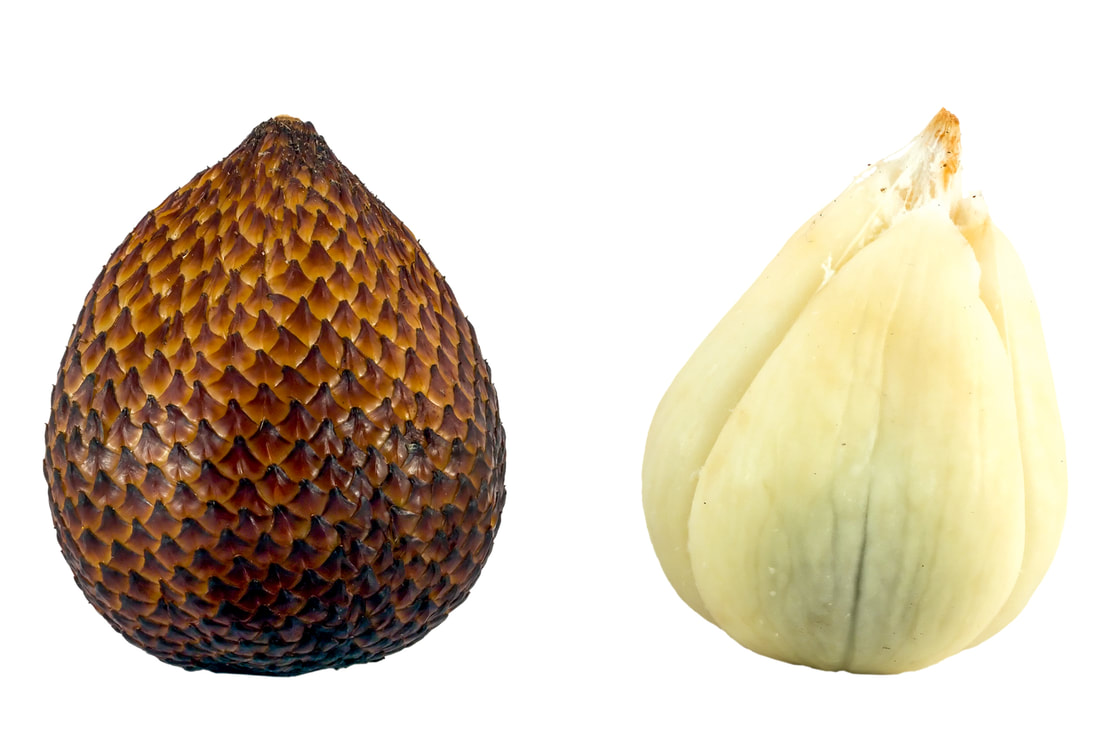|
This week, it has been one year since our last guests left the resort. What we all thought would be «a few months» until it would be «over» turned out to be a long year of waiting. First, we were waiting for the end of the pandemic all together, waiting for the Indonesian borders to reopen, and waiting for international tourists to be allowed to travel again. Then, it became waiting for infection numbers to go down, waiting for governments to decide on new restrictions or loosening them and then we started waiting for vaccines to be developed. Last March, we still hoped that our friends would be able to come in May. When this was cancelled, I hoped for my daughter to be able to visit me in July. After this was cancelled, I was hoping for September, as we had something very special planned for that month (more on this when it will hopefully happen next year…). But, of course, all of this didn’t happen. Last summer, as infection numbers were going down in many countries, we were hoping for Christmas and decided to remain open for the first time in many years to try and make up a bit for the lost year. But, we all know, this didn’t happen either. I could go on and on, but you were all also hoping for many things to happen last year, which didn’t, so I won’t bore you any longer. When I wrote my blog post Keep on going in May last year, Maya asked me if I really wanted to talk about this after only a few weeks of lockdown. I told her that I thought it was a good moment, thinking it was already pretty hard to motivate myself and that it couldn’t possibly take much longer until we were able to have guests again. Now, I know better. But as much as we all long for the resort to reopen again, we also have become much better at dealing with the situation by now. Which is normal, I guess, as it was something we had to learn, like a new task. We had to get used to not have contact with anyone outside of Pulau Pef. This was our own decision as we wanted to keep our island virus-free by all means. But we also had to get used to not go to Sorong or see our families, as many of our employees were planning to do in May for Idul Fitri. Travelling wasn’t allowed by the government for all of Indonesia, and this was probably the hardest part for our Muslim employees. But we also had to get used to having more free time. Our holidays were being deducted in the form of off afternoons, so as not to end up with everyone leaving towards the end of the year. What to do with so much time on a small island? Our staff may have had less problems than me, as I am just not the person to hang around and do nothing. But I learnt to deal with this additional time and developed a routine that I have gotten to rather like by now. Many of our staff also had to get used to working different jobs on the island. Take our dive team, for example. After thoroughly cleaning all our dive gear, they have been renovating the walls of all our buildings since last spring. Almost every day, unless our boats had to be cleaned or something at the dive centre needed their attention. Sticking leaves of palm trees into walls and fixing them with ropes all day long, when you are used to spending at least half your waking hours under water, guiding guests through the most beautiful reefs on earth, is for sure not the most motivating task. I don’t blame them for getting a little annoyed by it. But it needs to be done when there are no guests, so there you are. But others are also constraint to repetitive work. Our housekeeping, for example. They have been cleaning the bungalows inside out for months. And once they finish at one end, they need to start at the beginning again, because the salty air has already annihilated their efforts again. Or our kitchen team, for another. When we have guests, they usually cook a big variety of exquisite meals every day, including their famous desserts in the evenings. Now, it is mostly rice, vegetables and fish or chicken. They really try their best with what they have and I’m not complaining at all. The variety is still incredible, but I imagine that they also miss the challenge to cater for our guests.
The daily routine for my colleagues in operations is also quite different from «normal» times. They are usually busy managing everything around resort life, checking here and there if things are running smoothly, tending to our guests’ requests and helping out in the kitchen or with housekeeping if need be. Now, they still have a few of their original tasks, such as coordinating supply orders with our logistics team in Sorong, but otherwise, they help out wherever an extra hand is needed. We are all counting the days, weeks and months until we can have our normal jobs back. But until then, we are just happy to still have a job, which is more than many others have at the moment…
0 Comments
Last Saturday, I went diving again! This may seem like no big deal since I work at a dive resort. But it’s actually been almost one year since I last put on my dive gear and rolled over backwards from a boat! Without guests and no income since last April, we didn’t go diving to save fuel and money. I often went snorkelling at our house reef which is lovely, and I still enjoy it very much. But only when I was down there did I realize how much I had missed it! I had almost forgotten how utterly amazing Raja Ampat is under water and felt like the first time I came to this incredible place. If you don’t dive it’s hard to understand what it’s like to dive here. The marine life is just so abundant, you sometimes don’t know where to look for fear of missing something swimming by on the other side.  We actually went for a staff picknick at Yembraimuk island, about 20 minutes by boat from Pulau Pef, and some of us did two dives there. It was also part of the training we started with our dive guides and boat crew to slowly get them back into shape for when we can have guests again. Even though we still don’t know when this will be, it will take them a while to get used to the routine of getting everything ready, give a briefing in English and guide under water again. Since last April, most of them have only put on their dive gear to clean the boats, or on rare occasions such as planting new corals or placing our statues under water. So, it’s win-win – they get to train, and I get to dive! Before getting in the water I had actually feared I might have forgotten everything about diving after all this time. But as soon as I was in, I felt like a fish in the water again. The visibility was great, and we were immediately greeted by beautiful corals and big schools of fish. From tons of barracudas circling us to at least 5 wobbegong sharks in the sand and under bommies (but also one swimming gracefully in front of our eyes), from flounders in the sand and colourful little nudibranchs on rocks and corals to jacks and mackerels hunting in the blue, from filigree lionfish to fierce-looking scorpionfish, from the shy yellow boxfish, quickly disappearing under a coral, to the mantis shrimp eyeing me suspiciously in front of its hole without moving, from the crocodile fish camouflaged in the sand to big schools of yellowtail fusiliers flashing their colours, from the tiny filefish swimming away as quickly as it could to the big porcupine fish that didn’t seem afraid, from busy clownfish bustling about their anemone to the big bumphead parrotfish, from the giant moray eel showing its teeth to intimidate us to the schools of batfish crowding the blue, from the lobsters waving their antennae hidden in their crevices to garden eels curiously sticking their heads out from the sand - we saw them all and much more. I felt completely flashed and overwhelmed! Whenever I’m under water, I feel humble and honoured to be able to enter a world that doesn’t belong to humans. I feel like a guest that is invited to look, but not to participate. When I started diving in Australia more than 20 years ago, I was told to «take nothing but pictures, leave nothing but bubbles». This is what I still do – look and be amazed! Unless there is a lot of current (Raja Ampat is known for current...), the underwater world feels peaceful, but it is far from quiet. The divers are the loudest with their regulators making a lot of noise and their bubbles stirring up the water. But the fish make their own noise, either by biting off chunks of the reef when feeding or by nibbling on rocks and thereby producing a constant crackling background sound.
It’s a whole new world down there, and I am so happy to be able to experience it while it is still in such good shape here in Raja Ampat. When taking a coffee break between the two dives and also during lunch after the second dive, I constantly reminded myself of the incredible luck I have to be able to experience this beauty, while the rest of humanity is more or less confined to its own four walls and can only dream of coming here some time in the future. My life on the island may not always be easy. But moments like last Saturday make up for everything that I miss here, and I intend to enjoy it to the fullest! I only wish I could share it with you all… Living and working on a very remote island, we don’t have the possibility to purchase things just around the corner. Whenever something breaks, we have to first try and repair it before we can consider buying something new. And even if we do decide to buy new, there is always the problem of importing material from outside of Indonesia which usually ends up being very expensive because of the high import taxes. So, we try to find another solution. If it’s something that is not too big or heavy, we sometimes ask friends and family who come to visit us, if they could bring some of it in their luggage. And Maya carries tons of material with her whenever she comes from Switzerland! If it can be fixed, our technical and construction teams will do everything they can to fix it. They’re amazing what they manage to repair. For example, have you ever tried to weld cooking pots? I guess not, I certainly haven’t. Well, here we do that. With the salty air, the corrosion is very high, so pans and pots suffer a lot and need to be maintained regularly. Which may also mean welding if they break or have a hole somewhere. We also replaced the plastic handles on the pots by nice wooden ones after they broke. And our construction team even removed the rust from our freezers and covered the lid with a fresh coating so that it looks bright and shiny again. Take our various Yamaha outboarders that our boats are equipped with, for another example. Some of them have been in use for 10 years already, and this in salt water! You would think that we would have had to replace them a long time ago. But no, thanks to excellent maintenance, they are still in good shape and in daily use when we have guests. Even now, that we didn’t use them every day because there were no guests for almost a year, they were still maintained on a regular basis, as if we were to go diving again tomorrow (I wish…). Ventilators, water taps, the coffee machine, scissors, you name it – we fix it! It is not only a matter of money or availability of material, but also a question of not throwing away things so quickly. Especially in an area of the world where recycling is not a given option and waste management still in its infancy. We hardly throw away anything, even at the office. From used paper that we re-use as scrap paper for our notes or for prints that don’t require a fresh paper, to ribbons that we used for a birthday gift or some kind of decoration - we keep it and re-use it whenever possible. Apart from re-using and repairing things, we also build from scratch on the island what you at home would probably buy in a shop. Our wheelbarrows, for example, are hand-made on the island. And if you have visited us before, you may have noticed the rack that holds the water gallon in your bungalow. These are also made here. Things like cooking utensils, cooking spoons, etc., everything is made from local wood by our construction team. And the latest addition to the series are beautiful wooden buttons that our assistant Surya sowed onto the fabric roofs of our dive boats. Together with the Velcro, they will help prevent the roof from being torn off by the wind when driving at full speed. Oh, and by the way – the fabric roofs are also made and repaired on the island. And if the sowing machine breaks down because the corrosion is getting too much for it, guess what happens? We try to fix it! The idea for this week’s blog post actually came from yet another one of our DIY activities. Whenever there is a celebration of any kind, we decorate the resort with leaves, flowers, ribbons, food or whatever else fits the occasion. Be it a honeymoon decoration in one of our bungalows or the nicely woven palm leaves for a religious holiday – we always put a lot of effort into details and often create something out of whatever we have available. The next holiday coming up will be Easter. So, we had this idea for a... no, wait! I’m not going to give you any spoilers! Let’s just say that we needed some funny bunny ears. Well, my office colleagues didn’t need much convincing to get busy and after 2 days came up with this:
Food is important, especially if you are on a remote island with not much distraction. And Indonesians love to eat, so they talk about food a lot. Maybe not the Papuans so much, as their menu tends to be dominated by rice, fish, and whatever vegetables their village or family garden produces. But since many of my female colleagues are from Java and love to cook and eat, we talk about Javanese dishes a lot. During regular operation with guests, we have a guest buffet and a staff buffet. The staff buffet usually features local dishes composed of rice (for breakfast sometimes also noodles), vegetables and either fish or chicken, sometimes even both. Very often there is also tofu or tempeh, as not only vegetarians like both. Our guests are welcome help themselves from the staff buffet, but only the adventurous ones usually do. Most stick to the guest buffet which features a mix of Asian and western menus. It is excellent, and our kitchen team gets a lot of compliments for conjuring up such a variety of dishes with the limited possibilities we have here on the island. On various occasions, I’ve been asked if there were any produce they use here that I didn’t know before. The first thing that comes to my mind is the «Papeda», a congee from the sago tree that is typical for eastern Indonesia. It is used as a basic food and the counterpart to rice which is more used in western and central Indonesian cuisine. Papeda is made from sago starch that the locals get from cutting the sago palm tree in half and scraping the soft inner parts, producing a crude sago pith flour. Papeda is then made by cooking the sago starch with water until it has a glue-like consistency. And that’s exactly what it looks like – glue! I tried it once and didn’t particularly like it, but maybe it was just the look of it that made me dislike it. I may have to try it again, with less prejudice, to give it a second chance. But then again, I really like my rice, so why bother? What I absolutely love, on the other hand, is the Salak fruit! It is also known as the «snake fruit» due to its reddish-brown scaly skin. It is about the size and shape of a ripe fig, and the pulp is what you eat. The palm tree it grows on is native to Java and Sumatra, but it also grows in other areas of Indonesia. Inside, the fruit consists of 3 pieces which look like big peeled garlic cloves. They have an apple-like texture and taste sweet and acidic, with a strong astringent edge. Not all our guests like them, but I’m absolutely addicted. We buy them in Sorong as they are not cultivated here, but when we have guests, there are always some in the big fruit basket at the restaurant. As they don’t keep very long, you have to eat them rather quickly, which is why we don’t always have them now. Our water and food supply only comes every 3-4 weeks at the moment, so we need to make sure we only order things we can keep for a while. But yesterday, I was told by our cook that there are some Salak in the fridge and that I was allowed to have some. What a joy, I really missed them when I was back home! One of the things I had to get used to is the fried food they eat in Indonesia. Especially fish (I don’t eat meat, so I couldn’t tell) is fried for a very long time until it gets hard and dry. They like it like this here. And they also like to eat small fish with lots of bones, so they can chew and work on them for a long time. I haven’t learned to deal with this yet because, in order to avoid swallowing fish bones, it just takes me so long to eat that everybody else has left the restaurant by the time I’m about half way through. The kitchen team anticipates this by now and either cooks me eggs or a piece of fish with less bones. Thank you, guys!
The endless variety of chilies was also new to me when I arrived here. I love our home-made Sambal, but I didn’t know that there are so many different variations of it. Depending on the size and type of chili, and whether it’s cooked or raw, the Sambal turns out differently. Sometimes, it is hot as hell and sometimes it seems very moderate (or have I just gotten so used to eating spicy food?). And there are certain types of Sambal that go with certain types of food. There is one of the uncooked types they usually serve with grilled fish that can be particularly spicy, even though it looks very innocent. So, you better watch out when you help yourself generously to what looks like a raw salad of small cut tomatoes, cucumbers and herbs! Currently, the variety of our dishes is a little limited as we have to save money and adapt to the rarer supply transfers. We don’t have as many different types of fruit as when we have guests and the choice of vegetables is smaller. There are often eggs instead of meat or fish, but I don’t mind that. So, don’t worry! We still get enough food and it continues to be delicious. And if I end up losing a little weight in the process, even better. Then I’ll be ready to dig into the delicious deserts our kitchen team creates every evening when our guests come back! |
#TalkingWithMangrovesI never even dreamt of working on a remote island in Indonesia, but life has a way of taking care of itself… Archives
May 2021
|
LocationPulau Pef - Raja Ampat - Indonesia
|
Follow Us
Our Office in SorongJl. Gagak No.7 B, Km 7 Gunung, RT.001 RW.002
Kelurahan Malengkedi, Remu Utara PO Box No.130 Sorong 98416 – Papua Barat - Indonesia Phone +62 (0)811 485 7711 |
Rates and information are subject to change without notice. Terms and Conditions apply. All rights reserved.
Imagery is copyrighted and may not be used without express permission and written consent.
Images and videos of the following photographers / videographers were used for this website:
Barbara Moll, Claudia Peyer, Pere Rubio, Thomas Haider, Filip Staes, Christian Kaufmann, Dos Winkel, Duri Mayer, Jürgen Freund,
Daniel Brinckmann, Amanda Künzle, Joram Zimmermann, Ramon Sibold, Roman Keller, Barbara & Markus Aichinger, Fabienne Hadorn, Andreas Hadorn,
Armin Keller, Marcel Rudolph, Sabrina Inderbitzi, Peter Löseke
© 2024
Imagery is copyrighted and may not be used without express permission and written consent.
Images and videos of the following photographers / videographers were used for this website:
Barbara Moll, Claudia Peyer, Pere Rubio, Thomas Haider, Filip Staes, Christian Kaufmann, Dos Winkel, Duri Mayer, Jürgen Freund,
Daniel Brinckmann, Amanda Künzle, Joram Zimmermann, Ramon Sibold, Roman Keller, Barbara & Markus Aichinger, Fabienne Hadorn, Andreas Hadorn,
Armin Keller, Marcel Rudolph, Sabrina Inderbitzi, Peter Löseke
© 2024







 RSS Feed
RSS Feed

